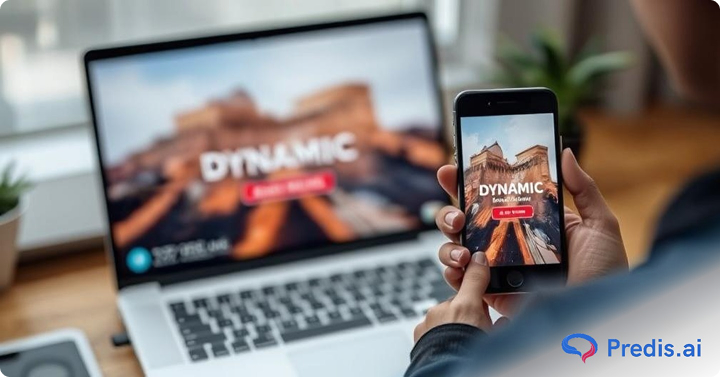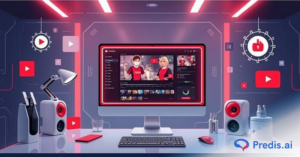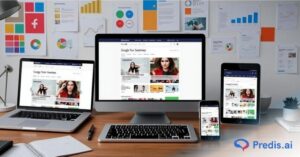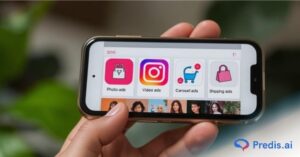Are you struggling to capture the attention of consumers in today’s saturated digital marketplace? You’re not alone. Standing out has become more challenging than ever due to millions of businesses contesting for attention online. Dynamic banner ads meet this challenge as a modern solution to classic marketing obstacles. It offers a convincing way to engage diverse audiences effectively and instantly by tailoring content based on user behavior and context.
This blog explores some of the most inspiring dynamic banner ad examples from various industries, showcasing how they successfully capture attention and provoke action.
We’ll also discuss how tools like Predis.ai can streamline the creation process, turning simple ideas into powerful visual statements.
Understanding Dynamic Banner Ads
Dynamic banner ads are designed to catch the eye and engage with the audience in a more personalized and interactive manner as well. These ads adjust automatically based on several factors. This includes the user’s age group, their browsing habits, and their past interactions with the brand.
This flexibility means each viewer sees content that feels especially relevant to them and this boosts the chances of them engaging with the ad.
Key Advantages of Dynamic Banner Ads:
- Increased Relevance: These ads grab attention by adapting to what viewers like and need. This personal approach feels more considerate and less pushy.
- Better Engagement Rates: They tend to get more clicks and interactions because the content resonates more closely with individual viewers. This can translate into better click-through rates, increased traffic, and higher conversion rates.
- Efficient Use of Advertising Budgets: It reduces resource wastage by focusing on people who are interested in what’s being offered. This targeted approach ensures that advertising budgets are spent more effectively.
- Real-Time Optimization: These ads can be optimized in real-time based on ongoing campaign performance data. This ongoing tweaking helps improve results even before the campaign ends.
The Role of AI in Crafting Dynamic Banners
AI is changing how dynamic banners are made and used, making them more personal and effective than ever. It can customize ads in real-time to fit each viewer by analyzing vast amounts of data like demographics, online behavior, and past interactions.
This data-driven approach ensures that each ad is relevant and perfectly timed to maximize impact.
- Enhancing Personalization: AI tools like Predis.ai utilize machine learning to predict what content will resonate best with different audience segments. AI makes adjustments like the call-to-action and promotional message based on the viewer’s previous interactions. This ensures each ad speaks directly to the viewer’s needs and interests.
- Boosting Effectiveness: Beyond personalization, AI contributes to the overall effectiveness of campaigns by optimizing various elements of the ad in real-time. This includes testing different layouts, colors, and messaging to see which combinations perform best. The result is a highly optimized ad that looks appealing and strategically sound.
Sign up on Predis to utilize Animated Ad Banner Ad Maker to streamline the creation process through captivating visuals.
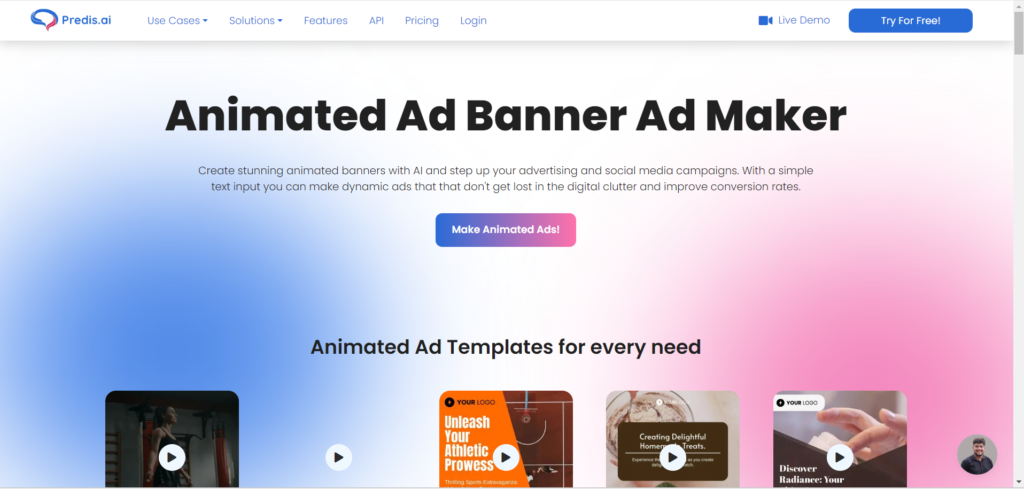
Technological Considerations for Dynamic Banner Ads
Dynamic banner ads are predominantly built using HTML5, CSS, and JavaScript. These technologies help create interactive and flexible designs, which are essential for dynamic advertising.
1. HTML5 is a modern coding language used to create web pages. It’s particularly useful for dynamic ads because it allows them to include videos and audio without additional software. This is particularly important for ads that need to display different media types based on user behavior or demographic data.
2. CSS (Cascading Style Sheets) controls the layout and appearance of the elements within the ad. It facilitates the quick re-styling of elements depending on the viewing context or user interaction. This helps in maintaining brand consistency across various scenarios.
3. JavaScript enables ads to respond to user actions in real-time. It includes changing content based on the user’s location or the time of day. It also helps in fetching real-time data that can be used to personalize ads to an even greater extent.
Case Studies of Dynamic Banner Ad Examples
Let’s examine real-world applications through detailed case studies. These examples will highlight successful dynamic banner ad campaigns and demonstrate the effective integration of design principles, technological tools, and strategic marketing.
1. Nike: “Reactland” Interactive Campaign
Nike launched an innovative, dynamic banner ad campaign titled “Reactland” to promote its new line of React running shoes. The campaign featured an interactive video game-style ad in which users could control an avatar wearing React shoes across various terrains.
Campaign Details:
- Technologies Used: HTML5 for interactive elements, CSS for layout design, and JavaScript for real-time user interactions
- Targeting Strategy: Targeted active lifestyle enthusiasts across multiple digital platforms
- Outcome: Saw a significant increase in engagement, with a 30% higher click-through rate compared to traditional static ads, and boosted online sales by 27%

2. Old Spice: “The Man Your Man Could Smell Like” Campaign
Old Spice launched the “The Man Your Man Could Smell Like” campaign featuring humorous ads that became a viral sensation, significantly rejuvenating the brand’s image.
Campaign Details:
- Technologies Used: Standard digital advertising tools with a focus on social media platforms.
- Targeting Strategy: Targeted both men and women globally, utilizing the charm and humor of the ads to engage a broad audience.
- Outcome: Generated over 50 million views on YouTube and significantly increased product sales.
- Key Insights: Using humor and a memorable character like the “Old Spice Man” proved effective in creating viral content and enhancing brand recognition.

3. McDonald’s World Cup (Singapore)
McDonald’s leveraged the FIFA World Cup to roll out a global dynamic advertising campaign, enhancing customer engagement.
Campaign Details:
- Technologies Used: Geo-targeted dynamic ads featuring World Cup-themed promotions.
- Targeting Strategy: Soccer fans and fast-food consumers globally, with a focus on match times and relevant offers.
- Outcome: Increased sales and customer participation during the campaign.
- Key Insights: Event-based targeting combined with dynamic content can significantly enhance the impact of promotional campaigns.
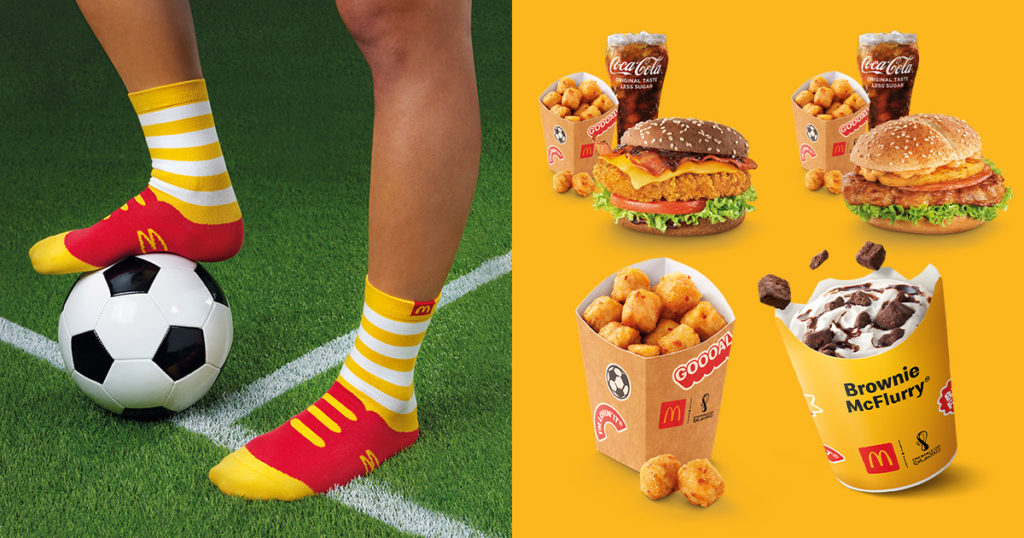
4. Aveeno by Johnson & Johnson (Malaysia)
Aveeno employed dynamic banners to promote skin wellness products by adapting to user preferences and regional market insights.
Campaign Details:
- Technologies Used: Advanced segmentation tools and real-time data to personalize ad content.
- Targeting Strategy: Targeted young adults and skincare enthusiasts across various digital platforms.
- Outcome: Improved brand loyalty and a significant increase in product sales.
- Key Insights: Tailoring ads to reflect user behavior and regional preferences can enhance relevance and drive sales.
5. Bank BCA Expoversary (Indonesia)
Bank BCA launched dynamic ads to promote their anniversary retail event, integrating real-time data to offer personalized banking products.
Campaign Details:
- Technologies Used: Dynamic content adaptation and real-time data integration.
- Targeting Strategy: Targeted existing and potential customers with tailored banking offers based on their financial behavior.
- Outcome: Enhanced customer participation and a significant boost in sales during the event.
- Key Insights: Integrating personalized offers in dynamic ads can significantly increase customer engagement and sales during special events.

6. Spotify: “Made for You” Campaign
Spotify launched the “Made for You” campaign to promote personalized playlists based on users’ listening habits. It has successfully demonstrated Spotify’s unique value proposition of music personalization.
Campaign Details:
- Technologies Used: Machine learning algorithms to analyze user data and dynamic ad technology to serve personalized content.
- Targeting Strategy: Targeted music enthusiasts on social media platforms and through in-app advertisements
- Outcome: Increased user engagement with a reported 35% rise in the time spent on the platform and a significant increase in premium subscriptions
- Key Insights: Personalization based on user behavior and preferences can greatly enhance user engagement and subscription rates
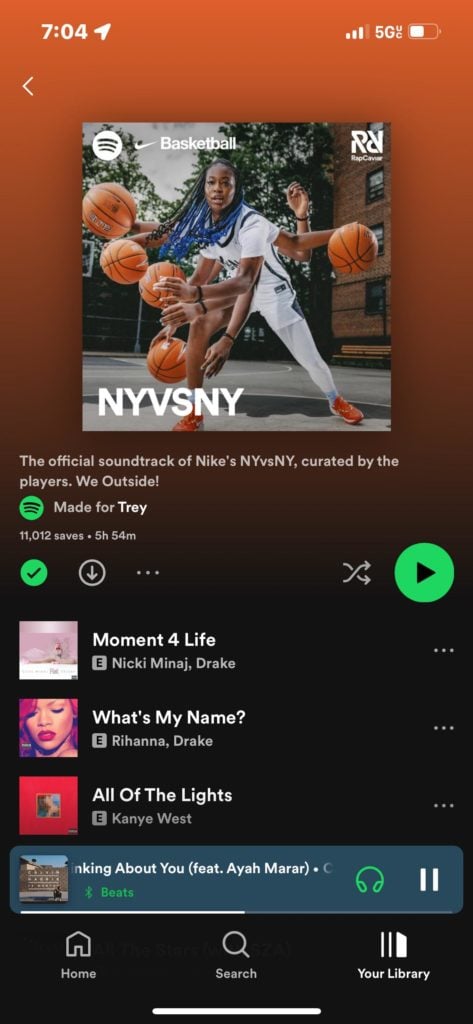
These case studies showcase how dynamic banner ads can be used in different industries to achieve remarkable results. By using advanced technology and smart targeting, these campaigns help increase engagement and sales and build stronger brand loyalty. These insights can help shape successful dynamic advertising strategies for the future.
Challenges and Solutions in Creating Dynamic Banner Ads
Creating dynamic banner ads presents a unique set of challenges that require innovative solutions to engage audiences and drive conversions, such as:
1. Complexity in Implementation: Creating dynamic banners involves a combination of design, technology, and data analytics, which can be complex to implement effectively.
Solution: Utilize comprehensive platforms like Predis.ai that integrate these elements seamlessly. These tools simplify the process of creating and providing templates and automation features that can handle complex tasks. That way, you can utilize the time to focus on strategy and creative content.
2. Data Privacy Concerns: Dynamic ads rely heavily on user data to personalize content, which can raise privacy concerns among consumers.
Solution: Ensure compliance with data protection regulations such as GDPR and CCPA by implementing clear consent practices. One effective step is to add a cookie consent banner to your website or ad platform. This allows users to manage their data preferences and ensures that any personalization is based on informed consent. Not only does this enhance legal compliance, but it also builds user trust.
3. Maintaining Relevance: Keeping the content of dynamic ads relevant and timely can be challenging, especially in rapidly changing markets.
Solution: Implement real-time data feeds and continuous performance monitoring to adapt ads quickly to changing conditions. Regular updates and A/B testing are crucial to refine content and targeting strategies.
4. Over-Complexity in Personalization: Over-customizing content for different user segments can sometimes lead to fragmented messaging that confuses the audience.
Solution: Strike a balance between personalization and consistency. Ensure that all dynamic content aligns with the core brand message and campaign goals.
Make Your Product Stand Out on Social Media 🤩
TRY NOWConclusion
The dynamic banner ads examples discussed above have proven to be powerful tools in the digital advertising arsenal. They offer unparalleled personalization and engagement capabilities.
By exploring successful case studies, we’ve seen how leading brands like Nike, Old Spice, and McDonald’s have leveraged dynamic ads. These strategies have enhanced their marketing, increased engagement, and drive significant business outcomes.
These strategies boost engagement and significantly improve conversion rates and return on investment.
Dare to transform your digital advertising strategy? Embrace the future of dynamic banner ads with AI-driven tools like Predis.ai. Start crafting engaging, personalized campaigns that captivate and convert.
Sign up today to dive into the world of dynamic advertising and see the difference in your engagement metrics and sales figures. Experiment, innovate, and lead the charge in digital marketing excellence.
Create stunning banners effortlessly using Predis.ai's AI Banner Maker—boost your ad performance and conversions.
Related Content,
Is it worthwhile to Banner Advertise in 2024?
Complete Guide on Static vs Dynamic Banner Ads


